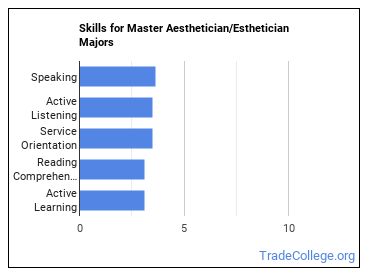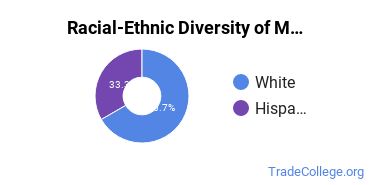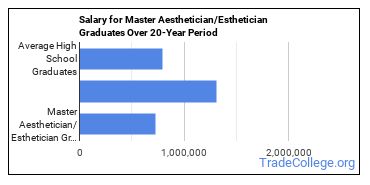Find Trade Colleges
Master Aesthetician/Esthetician
Types of Degrees Master Aesthetician/Esthetician Majors Are Getting
The following table lists how many master aesthetician/esthetician graduations there were in 2021-2022 for each degree level.
| Education Level | Number of Grads |
|---|---|
| Undergraduate Certificate | 1,015 |
| Basic Certificate | 709 |
| Associate Degree | 5 |
What Master Aesthetician/Esthetician Majors Need to Know
In an O*NET survey, master aesthetician/esthetician majors were asked to rate what knowledge areas, skills, and abilities were important in their occupations. These answers were weighted on a scale of 1 to 5 with 5 being the most important.
Knowledge Areas for Master Aesthetician/Esthetician Majors
Master Aesthetician/Esthetician majors often go into careers in which the following knowledge areas are important:

- Customer and Personal Service - Knowledge of principles and processes for providing customer and personal services. This includes customer needs assessment, meeting quality standards for services, and evaluation of customer satisfaction.
- English Language - Knowledge of the structure and content of the English language including the meaning and spelling of words, rules of composition, and grammar.
- Sales and Marketing - Knowledge of principles and methods for showing, promoting, and selling products or services. This includes marketing strategy and tactics, product demonstration, sales techniques, and sales control systems.
- Chemistry - Knowledge of the chemical composition, structure, and properties of substances and of the chemical processes and transformations that they undergo. This includes uses of chemicals and their interactions, danger signs, production techniques, and disposal methods.
- Administration and Management - Knowledge of business and management principles involved in strategic planning, resource allocation, human resources modeling, leadership technique, production methods, and coordination of people and resources.
Skills for Master Aesthetician/Esthetician Majors
The following list of skills has been highlighted as some of the most essential for careers related to master aesthetician/esthetician:

- Speaking - Talking to others to convey information effectively.
- Active Listening - Giving full attention to what other people are saying, taking time to understand the points being made, asking questions as appropriate, and not interrupting at inappropriate times.
- Service Orientation - Actively looking for ways to help people.
- Reading Comprehension - Understanding written sentences and paragraphs in work related documents.
- Active Learning - Understanding the implications of new information for both current and future problem-solving and decision-making.
Abilities for Master Aesthetician/Esthetician Majors
Master Aesthetician/Esthetician majors often go into careers where the following abilities are vital:

- Oral Comprehension - The ability to listen to and understand information and ideas presented through spoken words and sentences.
- Oral Expression - The ability to communicate information and ideas in speaking so others will understand.
- Near Vision - The ability to see details at close range (within a few feet of the observer).
- Speech Recognition - The ability to identify and understand the speech of another person.
- Speech Clarity - The ability to speak clearly so others can understand you.
What Can You Do With a Master Aesthetician/Esthetician Major?
People with a master aesthetician/esthetician degree often go into the following careers:
| Job Title | Job Growth Rate | Median Salary |
|---|---|---|
| Skincare Specialists | 13.7% | $31,290 |
Who Is Getting an Associate’s Degree in Master Aesthetician/Esthetician?
Racial-Ethnic Diversity
At the countrywide level, the racial-ethnic distribution of master aesthetician/esthetician majors is as follows:

| Race/Ethnicity | Number of Grads |
|---|---|
| Asian | 0 |
| Black or African American | 0 |
| Hispanic or Latino | 1 |
| White | 4 |
| International Students | 0 |
| Other Races/Ethnicities | 0 |
How Much Do Master Aesthetician/Esthetician Majors Make?
Salaries According to BLS
The median salary for someone in a career related to master aesthetician/esthetician is $36,350. This median refers to all degree levels, so you may expect those with a more advanced degree to make more while those with less advanced degrees will typically make less.
To put that into context, according to BLS data from the first quarter of 2020, the typical high school graduate makes between $30,000 and $57,900 a year (25th through 75th percentile). The average person with a bachelor’s degree (any field) makes between $45,600 and $99,000. Advanced degree holders make the most with salaries between $55,600 and $125,400.
Amount of Education Required for Careers Related to Master Aesthetician/Esthetician
Some careers associated with master aesthetician/esthetician require an advanced degree while some may not even require a bachelor’s. Whatever the case may be, pursuing more education usually means that more career options will be available to you.
Find out what the typical degree level is for master aesthetician/esthetician careers below.

| Education Level | Percentage of Workers |
|---|---|
| High School Diploma - or the equivalent (for example, GED) | 0.7% |
| Post-Secondary Certificate - awarded for training completed after high school (for example, in agriculture or natural resources, computer services, personal or culinary services, engineering technologies, healthcare, construction trades, mechanic and repair technologies, or precision production) | 87.3% |
| Some College Courses | 10.3% |
| Associate’s Degree (or other 2-year degree) | 1.8% |
Online Master Aesthetician/Esthetician Programs
The following table lists the number of programs by degree level, along with how many schools offered online courses in the field.
| Degree Level | Colleges Offering Programs | Colleges Offering Online Classes |
|---|---|---|
| Certificate (Less Than 1 Year) | 0 | 0 |
| Certificate (1-2 years) | 34 | 0 |
| Certificate (2-4 Years) | 0 | 0 |
| Associate’s Degree | 1 | 0 |
| Bachelor’s Degree | 0 | 0 |
| Post-Baccalaureate | 0 | 0 |
| Master’s Degree | 0 | 0 |
| Post-Master’s | 0 | 0 |
| Doctor’s Degree (Research) | 0 | 0 |
| Doctor’s Degree (Professional Practice) | 0 | 0 |
| Doctor’s Degree (Other) | 0 | 0 |
Is a Degree in Master Aesthetician/Esthetician Worth It?
The median salary for a master aesthetician/esthetician grad is $36,350 per year. This is based on the weighted average of the most common careers associated with the major.

Explore Major by State
Alabama
California
District of Columbia
Idaho
Kansas
Maryland
Mississippi
Nevada
New York
Oklahoma
South Carolina
Utah
West Virginia
Alaska
Colorado
Florida
Illinois
Kentucky
Massachusetts
Missouri
New Hampshire
North Carolina
Oregon
South Dakota
Vermont
Wisconsin
Trades Related to Master Aesthetician/Esthetician
You may also be interested in one of the following majors related to master aesthetician/esthetician.
References
*The racial-ethnic minorities count is calculated by taking the total number of students and subtracting white students, international students, and students whose race/ethnicity was unknown. This number is then divided by the total number of students at the school to obtain the racial-ethnic minorities percentage.
- College Factual
- College Scorecard
- National Center for Education Statistics
- O*NET Online
- U.S. Bureau of Labor Statistics
- Usual Weekly Earnings of Wage and Salary Workers First Quarter 2020
- Image Credit: By Tiffany Bumgardner under License
More about our data sources and methodologies.
